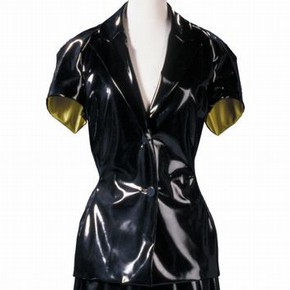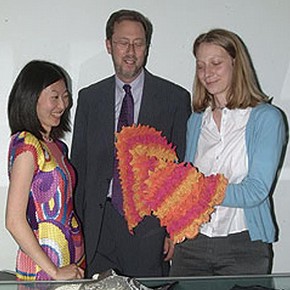Conservation Journal
Autumn 2005 Issue 51
Smart and Techno Fabrics: fundamental properties of new fibres and their future
This collaborative project, funded by an Arts and Humanities Research Board (AHRB) Innovations Award, brought together the Textile Conservation Centre, University of Southampton (TCC) and the Victoria and Albert Museum (V&A) to explore fundamental issues in the understanding of the long-term behaviour of smart and techno-textiles in a museum context. A clear definition of smart and techno-textiles encompassing design and technology does not exist. Smart and techno-textiles can respond to environmental changes, like any other textile. However, specific responses can be built into them, allowing them some 'initiative' so that the textiles can react to external stimuli and can change their own state and functionality. For example, the material used to make the outfit by Owen Gaster shown in Figure 1 is made of thermochromic polyvinylchloride (PVA) fabric.

Figure 1. Thermofabric outfit by Owen Gaster, V&A Museum, T.23:2-1997. (click image for larger version)
Dr. Capucine Korenberg (Figure 2) was the project's first Research Fellow. She undertook analytical research into a range of smart and techno-textiles including untreated, treated, spattered and 'shibori' permanently pleated polyester1 which is very stretchy and very small when not worn, thermochromic coated polyvinyl chloride (PVC) and polyester, treated silk and polylactic acid fibre, a new fibre designed to be biodegradable. Dr Brenda Keneghan, Polymer Scientist from the V&A Science Conservation Section, and Marion Kite, Senior Conservator from the V&A Textile Conservation Section, were directly involved in the research. The resources of the Textile Conservation Centre, University of Southampton, the V&A, the British Museum and Imperial College were used for the analytical phase of the project. Techniques such as Fourier-transform infrared spectroscopy (FTIR), energy-dispersive X-ray fluorescence (EDXRF) and mechanical testing were employed to analyse the behaviour of light and heat-aged samples. Given the complexity of smart and techno-textiles, which may incorporate electronic components and sensing elements, it was decided to focus the initial analytical phase of the work on a limited number of polyester-based fabrics with relatively limited smart and techno capabilities, but representative of the V&As textile and dress collection. Comparable examples were sought rather than sampling accessioned items. This proved difficult and the Executive Committee of the project is most grateful to Nuno Corp, the Japanese firm renowned for its innovative textiles, for providing samples for analysis.

Figure 2. From right to left: Dr Capucine Korenberg, Professor Graham Martin and Makiko Matsumara, an MA Textile Conservation student at the TCC with a range of smart and techno fabrics, reproduced courtesy of the Textile Conservation Centre, University of Southampton. (click image for larger version)
-
identification of types and subcategories of smart and techno-textiles
-
understanding their technologies, properties and functionality
-
identification of suitable conservation practices taking into consideration the acquired information
The project was successful in bringing together the expertise of museum specialists, conservators, conservation scientists, material scientists and engineers to develop a body of knowledge about smart and techno-textiles. A genuine interdisciplinary network has been developed which will enable the development of future project proposals to further research in this new and complex area.
Dr Korenberg's analytical research indicated that the current preventive conservation regimes used for clean and unused polyester-based, new and artificially aged smart and techno-textiles are appropriate. The analytical regime developed provides a framework for further characterisation of the long-term behaviour of more complex smart and techno-textiles as well as, critically, for the worn and soiled examples which are usually encountered by curators and conservators. A conceptual framework for approaching museological, conservation and ethical issues presented by smart and techno-textiles was also developed. Dissemination to both specialist and general audiences has drawn attention to issues involved in the collection and preservation of these innovative textiles.
The completion of this pilot project is best to be considered as the basis for future investigation. Further research is required into the effect of a museum environment on these innovative textiles, covering all their various types and subcategories.
Acknowledgements
The authors would like to thank the Executive Committee including Dinah Eastop, Dr. Paul Wyeth,
Dr. Alan Chambers, Dr. Paul Garside, Professor Graham Martin, Dr. Brenda Keneghan and Marion Kite. Also, the authors would like to acknowledge the support of the Advisory Group, which advised the project's Executive Committee, including Dr. Susan Mossman, David Grattan, Rob Huddleston, Professor Martin Simock, Georgina von Etzdorf, Dr. Yvonne Shashoua, Dr. Jennifer Harris and Amanda Fielding. Thanks are also due to Nell Hoare, Director, Maria Hayward, Head of Studies & Research and Mike Halliwell, Conservation Photographer, Textile Conservation Centre.
References
(see also http://www.shibori.org/home.htm, last checked on 2/6/2005).
Further reading
1. C. Korenberg and M.M. Brooks, 'Tackling the Conservation Issues Posed by Tomorrow's Fabrics', Proceedings of the First International Textile Design and Engineering Conference, Edinburgh, U.K., 2003.
2. L. Dokos and M.M. Brooks, 'Smart and Techno Fabrics:
a framework for conservation analysis and decision making', Proceedings of the 11th International Conference on Composite/Nano Engineering (ICCE11), Hilton-Head Island, SC, USA, 2004.
3. L. Dokos, M.M. Brooks, Brenda Keneghan, Marion Kite, Capucine Korenberg and Graham Martin, 'Smart and Techno Fabrics: the effect of a museum environment on their mechanical properties', Poster in Proceedings of the 11th International Conference on Composite/
Nano Engineering (ICCE11), Hilton-Head Island, SC, USA, 2004.
4. C. Korenberg, 'How fast do polyester fabrics age in the museum environment?', V&A Conservation Journal, vol. 44, pp.6-8, 2003.
Autumn 2005 Issue 51
- Editorial
- The new miniatures gallery
- Fur trade legacy
- Into battle: Conservation of a Venetian shield
- Smart and Techno Fabrics: fundamental properties of new fibres and their future
- RCA/V&A Conservation: Study trip to Rome, April 2005
- Presentations involving V&A staff accepted for the ICOM-CC 14th Triennial Meeting held from 12-16 September 2005 in The Hague
- Lustre ceramics analysis using the MOLAB facilities
- RCA/V&A Postgraduate Conservation Programme
- Printer friendly version